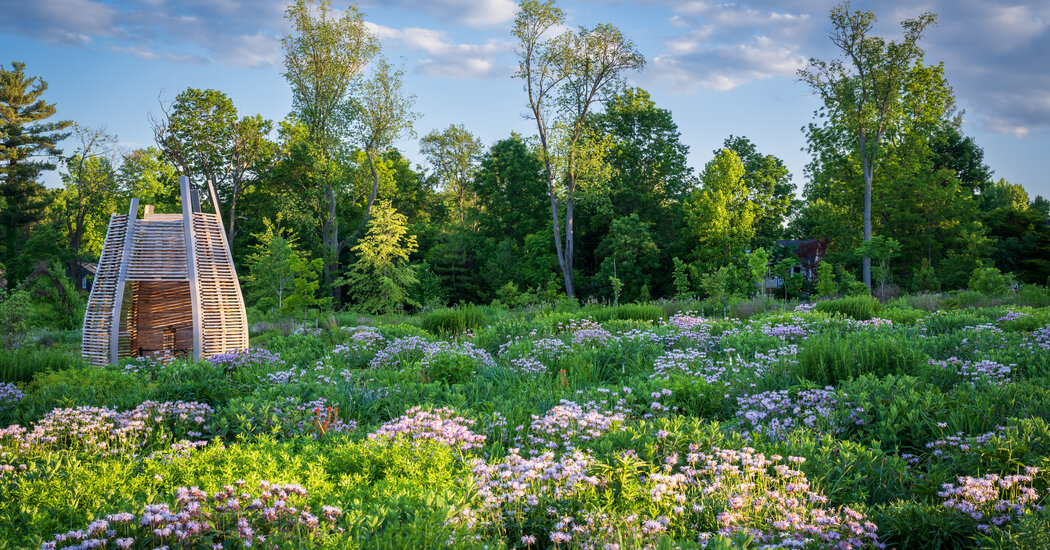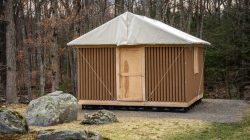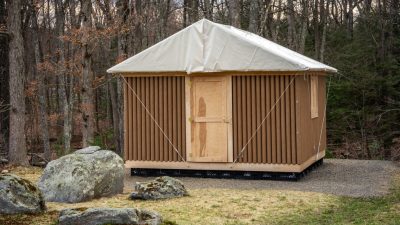If you want to gauge the effect of a planting design, try letting a 5-year-old loose around it. Then watch his body language.
Chances are, the local insects will confirm the child’s findings, gravitating toward abundance and exuberance, as the child did.
As these two distinct but discerning live-audience samples concur, more is better: more flowers, more color, more life. Our traditional lawn- and hardscape-heavy landscapes can’t compete.
Making landscapes that are not only biophilic — celebrating and reinforcing our essential connection to nature — but also ecological is the focus of the landscape architecture firm Phyto Studio, founded in 2017 by Claudia West and Thomas Rainer.
The pair are also the authors of “Planting in a Post-Wild World,” which the ecologist Douglas W. Tallamy called “the universal how-to guide to sustainable landscaping we have all been waiting for,” when it was published in 2015.
A garden is at its most effective — by both biophilic and ecological measures — the Phyto team believes, when it is “immersive.”
Mr. Rainer remembers having that idea underscored when he and his wife, Melissa Rainer, who is also a principal in the Arlington, Va., firm, would take their young son to visit botanical gardens.
“When we’d go to a border or something very cerebral, you could just see his body go limp, and we’re dragging him through,” Mr. Rainer recalled. “And then when we’d get to a place like a little meadow with paths carved through, he would just start running. His body would just react to an interesting space.”
“Instinctively, we all gravitate toward these really rich plantings,” Ms. West said. “The cottage-garden styles where plants are mingling together — they’re social. You can just see how happy they are, full of life.”
The antithesis of those gardens are what she calls “under-vegetated plantings” — a sad and environmentally costly reality, not just in American gardens, but internationally. Too much of our real estate, she noted, is occupied by lifeless mulch.
Moving beyond that requires a mind-set shift, she regularly reminds clients and lecture audiences, summing it up succinctly: “Plants are the mulch.”
Specifically, the Phyto designers seek to build in maximum diversity — what Ms. West refers to as the “ecological intensification” of a site — by using ecologically high-performance plants that match their aesthetic goals.
How can we make our home gardens more immersive? Ms. West and Mr. Rainer distilled some of the thinking that goes into each landscape they make, and choosing each plant.
Changing Your Mind-Set
Although many people worry that having a more ecologically responsible landscape means letting go of cherished plants — their peonies, perhaps, or roses — Ms. West and Mr. Rainer are quick to clarify.
It’s not about tossing things out, because most gardens have underused space. “It’s about letting things in,” Mr. Rainer said. Especially flowering plants — a win for people of all ages, and for wildlife.
But first, we have to readjust the way we see our surroundings. When rethinking any part of our garden, or starting a new one, what if we flip our idea of what the landscape looks like?
Instead of holding an image in your mind’s eye of a place dominated by grass and paving — which yours may well be right now — and trying to position a bed within it, visualize something else entirely.
“Imagine your site being initially 100 percent covered in planting, at 18 to 24 inches tall,” Mr. Rainer suggested. “And then you go in and mow through the spaces you want — the paths, the terraces, everything else.”
Doing that, he said, “kind of flips the default.”
Mowed lawn recedes from its wall-to-wall-carpeting role to one of strategically positioned area rugs. “You still have a lawn,” he said. “But the lawn’s a beautiful shape, and it’s defined by planting all around it.”
In this way of thinking, planting areas are no longer merely placed here or there, as if they were objects, like the narrow foundation-planting beds alongside our houses or the tiny islands beneath trees surrounded by lawn. Now they’re the main event.
And a clump of this or that plant won’t do. Individual plants are not objects, either, but are selected to grow in carefully designed partnerships, like plant communities. Ms. West and Mr. Rainer develop resilient herbaceous mixes: several or more compatible, interlocking species of similar height, chosen to create multiple moments of visual effect throughout the season.
In a project for the Friendship Garden at the U.S. National Arboretum, in Washington, for example, flowering spurge (Euphorbia corollata), with its clouds of tiny, white flowers, is the high-summer star. Foxglove beardtongue (Penstemon digitalis) blooms in May, following April’s golden ragwort (Packera aurea) and Robin’s plantain (Erigeron pulchellus var. pulchellus Lynnhaven Carpet), “each species lighting up the green carpet beneath,” formed by its companion plants, Ms. West said.
Another mix there includes the nonnative autumn moor grass (Sesleria autumnalis) with tufted hairgrass (Deschampsia cespitosa), Eastern beebalm (Monarda bradburiana) and golden ragwort.
Phyto’s landscapes often have a savanna-like feel, with woody plants spaced farther apart than those in overstuffed foundation plantings. Resilient native trees like Southern magnolia (Magnolia virginiana), sassafras (Sassafras albidum) and staghorn sumac (Rhus typhina) are often limbed as they mature, so they achieve a multi-stem shape, with the blowzy perennial carpets below.
Use High-Performance Plants
While our initial impulse in buying plants often has to do with how they look, that is no longer the only filter Mr. Rainer and Ms. West use when developing landscape plans. As anthropogenic effects on the climate and nature have become more starkly front and center, Phyto’s plant-selection process has also evolved.
In the last 15 years, their emphasis has shifted from focusing on what is naturalistic in appearance and spirit to what they call a “systems-based approach” — emphasizing plant functionality over form. A plant’s ecological impact ranks much higher in the decision-making criteria as they develop each planting palette, which includes not just natives, but also nonnatives.
From their collaboration on a pollinator garden at Penn State University’s arboretum, working with scientists at its Center for Pollinator Research, Ms. West cited one big takeaway: “Not all native plants are created equal. And there are many European plants that have high ecological value.”
“We already live in a very disturbed world,” Mr. Rainer said. “It’s not about going back to some kind of purist version. It’s really just about embracing abundance and seeing the spots where we can have more in our gardens. And then just enjoying the more that that brings.”
To support pollinators, for example, Phyto’s list of workhorses might include golden Alexanders (Zizia aurea) or white old-field aster (Symphyotrichum pilosum), and many of the mountain mints (Pycnanthemum). But nonnative perennials like calamint (Calamintha nepeta), the catmints (Nepeta) and Caryopteris are also part of the mix.
Weighing the Realities of Maintenance
Another key filter the partners at Phyto use when deciding which species make the cut: a plant’s potential to hold up in a particular place and under its particular pressures.
That means Mr. Rainer and Ms. West have a lot of hard conversations with clients, explaining why current realities — related to climate, pests, diseases or other factors — make certain species, albeit beautiful ones, a poor choice.
“We design from a maintenance perspective up,” Ms. West said, “first understanding the realities, and not having any botanical fantasies in an area where it’s not going to survive.”
What they are after in the mixes they formulate, she said, are “good team players to keep a certain level of biodiversity alive long-term.”
In a high deer-pressure location, for instance, white snakeroot (Ageratina altissima), mountain mint and golden Alexanders — aggressive, deer-tolerant species — may get top billing. Monarda bradburiana resists herbivory, too, and offers mildew resistance in a shorter, earlier-blooming version of beebalm.
The relationships between plants and pollinators have become increasingly important in Phyto’s work. Among the many native species, some are extremely high-performing in attracting specific kinds of pollinator groups or birds, “and really hold a pollinator community together, and are at the core of it,” Ms. West said.
They are the ones at the top of the list. Research from Penn State, the University of Minnesota, Mt. Cuba Center, in Delaware, and the University of Maryland, among other sources, has proved invaluable.
The beneficial insects are also happy to provide their own recommendations.
“If you go out in your garden and something is blooming, and you see a lot of pollinators on it, and it’s a really nice flower,” Ms. West said, “add a million more of that. Find the space for them, to create bigger flower events. Be surrounded by it. Indulge in it.”
Or, as Mr. Rainer put it: “Introduce an element of hedonism to ecology — you don’t have to suffer or be puritanical to be good. Embrace the pleasure.”
Margaret Roach is the creator of the website and podcast A Way to Garden, and a book of the same name.
For weekly email updates on residential real estate news, sign up here.
Sumber: www.nytimes.com












